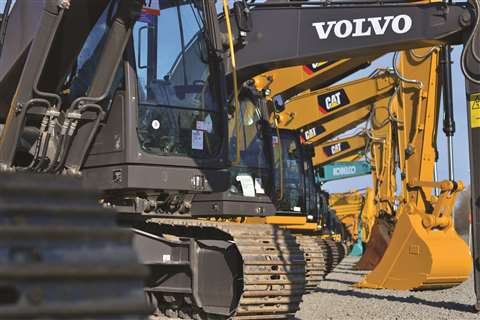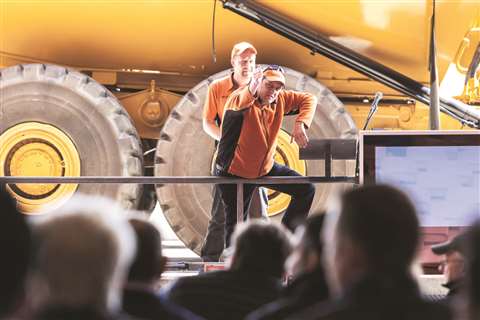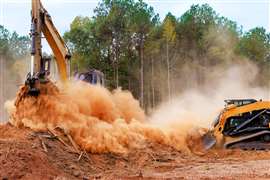Industry interview: Bidding for success
04 September 2020
An exact figure regarding the value of used construction equipment sold every year is impossible to come by, due to many transactions taking place in private. However, it can be said with a high level of confidence that the figure is easily in the hundreds of billions of US dollars every year. Auctioneer Ritchie Bros. sell more than US$5 billion worth of used equipment around the world globally, with approximately 85% of that construction equipment, from mini excavators all the way up to giant cranes.

On a late afternoon call in the UK, early morning in the US, Karl Werner, president, international, Ritchie Bros., told International Construction how the company has adapted to the challenges presented by Covid-19 and that the used equipment segment is holding its value.
Despite the call taking place at 8.00am in the US, Werner (who had already, astonishingly, been up for four hours by the time of the call) was enthusiastic and open as he revealed that the company was actually very well placed to deal with the issues brought about by Covid-19.
“Online participation has grown quarter after quarter throughout the years. Pre-Covid approximately 75% of the buyers at Ritchie Bros. auctions were online,” he comments.
When Covid hit he says that, “Over a weekend, we came up with this plan to say to customers, look, you can come in and inspect the equipment where it’s approved by the authorities but we will limit the number of people in the yards at one time and practice social distancing.” Because of Covid the company changed from live onsite auctions with online bidding to fully online auctions. Werner adds that, “Over a weekend, the plan was launched and it’s been very successful.”
Slightly different versions of online auctions are taking place in North America, Europe and Asia-Pacific to cater for different market requirements, but the key point is that business has been able to carry on. People are still buying used construction equipment and, interestingly, the prices for used equipment have held steady.
“The most intriguing scenario now that we’re seeing is that demand is actually fairly steady globally. We’re seeing pricing holding up – we haven’t seen any price erosion to speak of,” says Werner. He attributes a lot of this to the uncertainties that the global pandemic has brought in its wake.
“There’s still a lot of business going on in the world, but there’s also uncertainties. If you have a project that’s coming up are you going to go out and buy new machines that you’re going to be paying for over the next three years? Or are you going to buy a used machine, get your project done, and then liquidated after if there’s no business coming down the pipeline for you? The used market, in times like this, actually flourishes a bit. We’re also seeing that with dealers, they are confirming that new sales are down but used is still strong.”

Construction trends
The company, which has been operating for over 60 years, sells all types of construction equipment but Werner says that the biggest growth area is – ironically enough – in the smaller machines such as mini excavators and compact loaders. Another big driver has been emissions regulations; whenever countries raise the levels of emissions regulations the market for older and non-compliant machines gets smaller and smaller.
“Every time a country raises their emissions requirements it shrinks down the area where those older used machines can be sold. Right now, a bigger market for lower tier machines is countries in Africa, Middle East and some of Southeast Asia.”
Another issue is related to the higher levels of technology on newer machines. For example, even if a contractor based in, say, Nigeria wanted the highest specification wheeled loader available, it isn’t much good if the right spare part can’t be delivered to it quickly in the case of a breakdown or the right fuel isn’t available to run it.
Staying on the theme of technology, and Werner says that it is now a ‘given’ for buyers in developed countries to want construction equipment with inbuilt technology and it is a trend that is accelerating. He adds that, “Technology is just transforming the industry itself, it is truly amazing.”

If technology is a must for some buyers, then what else are they looking for? An experienced hand, Werner refuses to be drawn on the question of which OEMs equipment is viewed as more valuable than others by buyers, but does say that those attending auctions, be it in person or virtually, are more savvy than ever before.
“Today’s buyers are way more educated and informed. They look at total cost of ownership, so that means all your maintenance costs, your ownership costs and how much the machine is going to be worth in five years,” he says.
“If you’re buying machine X and you’re running it, the fuel cost is X, the maintenance cost is Y and at the end of five years, you’re going to sell it for, say, 40% of what your new cost was. Machine Y has virtually the same operating cost, but you’re going to sell it for 50% of your original equipment costs. Those are factors that educated buyers are taking into consideration.”
While a lot of businesses have been suffering recently, Werner makes the point that he does not think that the construction industry has been anywhere near as badly impacted as it was in the financial crash of 2008-2009.
The company produce a used equipment market survey report and, for the US, estimate that for the three months ending May, prices for used heavy equipment declined 3% compared to the same time frame last year. In 2008-09 this percentage was closer to 20-25%, giving some indication as to the difference between the two downturns.
While some companies have fared better than others in this ‘new normal’ brought on by Covid, there is no doubt that the way that businesses operate will be changed by the impact of the pandemic. There was already a trend for meetings to take place remotely rather than in person, for people to work at home rather than out of the office and to use technology to improve efficiencies. In a world where social distancing is necessary these trends have hit light-speed.
Werner comments that, “I’ve been telling our team that if there was a trend pre Covid, this has accelerated that from 50 kilometres an hour to 150. Online mobile and technology was trending before, now it’s full speed. We’re not going back. There’s going to be new models that come out of this, the way people do business. A lot of eyes have been opened.”




